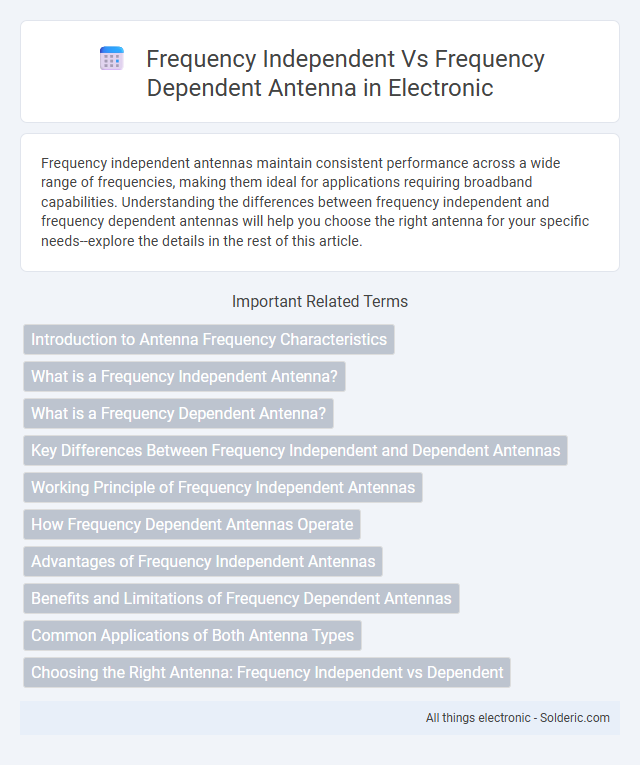Frequency independent antennas maintain consistent performance across a wide range of frequencies, making them ideal for applications requiring broadband capabilities. Understanding the differences between frequency independent and frequency dependent antennas will help you choose the right antenna for your specific needs--explore the details in the rest of this article.
Comparison Table
| Feature | Frequency Independent Antenna | Frequency Dependent Antenna |
|---|---|---|
| Operating Frequency Range | Wideband, covers broad frequency spectrum | Narrowband, optimized for specific frequencies |
| Impedance | Stable across frequency range | Varies with frequency |
| Radiation Pattern | Consistent over wide frequencies | Changes with frequency |
| Examples | Log-periodic, Spiral, Conical antennas | Dipole, Monopole, Yagi-Uda antennas |
| Applications | Wideband communication, spectrum scanning | Frequency-specific communication, broadcasting |
| Design Complexity | More complex due to broadband requirements | Relatively simpler |
| Size | Usually larger to maintain performance over frequencies | Compact, optimized for target frequency |
Introduction to Antenna Frequency Characteristics
Frequency independent antennas maintain consistent radiation patterns and impedance over a wide frequency range due to their self-similar geometric structure, enabling stable performance in varied applications. Frequency dependent antennas exhibit variations in radiation characteristics and impedance at different frequencies, often optimized for specific frequency bands to enhance gain or directivity. Understanding these frequency characteristics is crucial for selecting antennas suitable for broadband communication systems or targeted frequency uses.
What is a Frequency Independent Antenna?
A frequency independent antenna maintains consistent performance across a wide range of frequencies due to its geometric structure, which remains scalable with wavelength changes. Unlike frequency dependent antennas that rely on resonant elements tuned to specific frequencies, frequency independent designs such as log-periodic or spiral antennas provide stable impedance, radiation pattern, and gain over broad bandwidths. Your communication systems benefit from frequency independent antennas by enabling reliable, multi-band operation without the need for retuning or multiple antennas.
What is a Frequency Dependent Antenna?
A frequency dependent antenna operates efficiently only within a specific frequency range, as its electrical properties such as impedance, gain, and radiation pattern vary with frequency changes. This type of antenna is designed for targeted applications where performance at certain frequencies is crucial, like in traditional dipole or Yagi antennas. Your choice of a frequency dependent antenna should consider the intended frequency band to ensure optimal signal transmission and reception.
Key Differences Between Frequency Independent and Dependent Antennas
Frequency independent antennas maintain consistent performance across a wide range of frequencies due to their geometry scaling with wavelength, commonly seen in log-periodic and spiral designs. Frequency dependent antennas, such as dipole or Yagi-Uda antennas, exhibit optimal performance only within a narrow frequency band and their impedance and radiation patterns vary with frequency. The key difference lies in frequency independent antennas offering broadband functionality with stable gain and radiation patterns, while frequency dependent antennas provide higher efficiency and gain but only within specific frequency ranges.
Working Principle of Frequency Independent Antennas
Frequency independent antennas operate based on a design principle where their electrical characteristics, such as impedance and radiation pattern, remain constant over a wide range of frequencies. These antennas achieve this by utilizing geometrical shapes like log-periodic or spiral structures that scale proportionally with wavelength, ensuring consistent performance across diverse bands. Your communication system benefits from stable transmission and reception quality by using frequency independent antennas in multi-frequency applications.
How Frequency Dependent Antennas Operate
Frequency dependent antennas operate by resonating at specific frequencies, where their impedance and radiation patterns change significantly with frequency variations. These antennas, such as dipoles and monopoles, rely on physical dimensions tuned to particular wavelengths, causing performance to peak within limited frequency bands. Understanding how your frequency dependent antenna behaves is crucial for optimizing signal strength and ensuring efficient communication in targeted frequency ranges.
Advantages of Frequency Independent Antennas
Frequency independent antennas offer consistent performance across a wide range of frequencies, making them highly versatile for various communication applications. Their stable impedance and radiation patterns simplify system design and reduce the need for retuning, which can save you time and resources. These antennas are ideal for broadband and multi-band operations, ensuring reliable signal transmission regardless of frequency changes.
Benefits and Limitations of Frequency Dependent Antennas
Frequency dependent antennas offer precise tuning at specific frequencies, enhancing signal strength and efficiency for targeted applications such as broadcasting and radar. Their primary limitation is reduced versatility, as performance significantly drops outside the designed frequency range, restricting multi-band functionality. Despite this, they provide superior gain and better noise performance within their operational band compared to frequency independent antennas.
Common Applications of Both Antenna Types
Frequency independent antennas, such as log-periodic and spiral antennas, are commonly used in applications requiring wideband performance like spectrum monitoring, EMI testing, and broadband communication systems. Frequency dependent antennas, including dipoles and Yagi-Uda arrays, excel in applications where high gain and narrow bandwidth are essential, such as television broadcasting, point-to-point communication, and radar systems. Your choice between these antenna types depends on whether you need consistent performance across a wide frequency range or optimized operation at specific frequencies.
Choosing the Right Antenna: Frequency Independent vs Dependent
Selecting the appropriate antenna hinges on operational frequency requirements and application scope; frequency independent antennas, such as log-periodic or spiral designs, maintain consistent radiation patterns and impedance across wide frequency ranges, ideal for broadband applications. Frequency dependent antennas, including dipole and monopole types, offer optimized performance at specific frequencies but experience efficiency loss outside their designed frequency bands, suiting narrowband, high-gain needs. Evaluating antenna bandwidth, gain stability, and deployment environment ensures optimal signal integrity and system reliability.
frequency independent vs frequency dependent antenna Infographic

 solderic.com
solderic.com